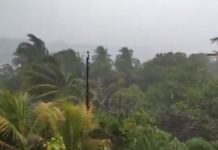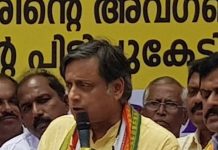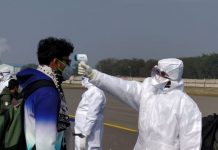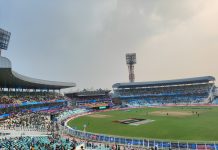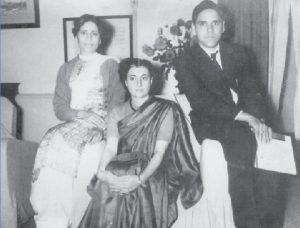 Let me begin at the beginning. While still a student, I had become a stringer in 1952-53 for three mainstream English daily newspapers. In the following year, I founded the VANGUARD Weekly in partnership with late Jitender Nath. During those days, one could count on the fingers of one hand the number of professional journalists in Dehra Dun. On his not infrequent visits to Dehra Dun, he loved staying in the Circuit House, with its vast expansive grounds and rich foliage. As his daughter and official hostess, Indira Gandhi generally accompanied Pandit ji.
Let me begin at the beginning. While still a student, I had become a stringer in 1952-53 for three mainstream English daily newspapers. In the following year, I founded the VANGUARD Weekly in partnership with late Jitender Nath. During those days, one could count on the fingers of one hand the number of professional journalists in Dehra Dun. On his not infrequent visits to Dehra Dun, he loved staying in the Circuit House, with its vast expansive grounds and rich foliage. As his daughter and official hostess, Indira Gandhi generally accompanied Pandit ji.
As a young journalist, my enthusiasm matched that of a new convert. Thus the visits of Pandit ji to Dehra Dun considerably whetted my journalistic appetite, and I often found myself cycling to the Circuit House. Those visits, though, were not necessarily for news reporting but I did occasionally send brief stories about his arrival with a couple of quotes on how relaxing he felt. Nehru didn’t believe in mixing business with holidays, and in fact, discouraged any official or political engagements. I don’t remember having encountered any PAs or PSs accompanying Nehru on his visits to Dehra Dun; though there must have been one or two of his aides but they generally remained inconspicuous.
Meeting Nehru was a child’s play
Meeting Prime Minister Nehru was then like a child’s play. No telephone calls, nor prior appointments. In fact, there used to be only one telephone with a 3-digit number at the Circuit House and it used to be picked up either by its caretaker or the all-pervasive bearer, Ram Prashad who had become an animated fixture in the Circuit House.
One winter morning in mid 1950s, I cycled right up to the porch of the Circuit House and parked my bicycle against its outer wall. A couple of constables with lathis stood at the main gate, a few lolled about in the front verandah while some other sauntered inconspicuously deep on the large lawns under the shades of giant trees.
Unhurriedly, I approached Pandit ji who was strolling on the lawns and introduced myself as a stringer for The Statesman and The Indian Express. “But I have no news to give”. Pandit ji said some words to that effect. “Yes, I know. And I have not come for news; I simply came to see you.” Pandit ji smiled. As I walked with him, I was tongue-tied. I couldn’t find anything interesting or provocative for breaking the ice. As someone more experienced, Pandit ji took the initiative to break the silence and asked me what subjects I studied at the College. Then in a rush of words, I briefly gave my academic background and further told him that I was the President of the DAV College Students’ Union two years before. That made him pause in his steps; he smiled again, and looked intently at me and then told me to come again if I wished. This implied invitation greatly encouraged and reassured me.
After his implied invitation, I must have subsequently met Pandit Nehru on five or six occasions in Dehra Dun. I also once took my sister with me, and Nehru talked with her for a while. On another occasion, I accompanied him on his visit to a village called Tuini in Chakrata. The front doors in the houses there were too low and The VANGUARD then published a photograph of Pandit Nehru entering a house half bent. When someone asked for the development of the backward Jaunsar Bawar area, Pandit Nehru delivered a long speech making out a strong case for what he then described as “integrated development of the whole country” rather than piecemeal growth of individual areas. In an open letter in The VANGUARD, I mustered enough courage and marshaled many arguments to challenge Pandit Nehru’s premise of “integrated development”. That article should certainly make an interesting reading even today after 65 years. How I wish I could find that back issue now? I would really love to read it again.
My most interesting encounter with Nehru, however, came about in Delhi. As a young reporter on the staff of The INDIAN EXPRESS, my regular “beat” was Delhi University. The Students Union of Irwin College (Sikandra Road) had invited Nehru at some function. At its conclusion, scores of girls approached Pandit ji for his autograph. He graciously allowed only five minutes to autograph hunters since he claimed he had an important meeting to attend.
Long after the queue of autograph seekers had vanished. Nehru was still there; he sat cross-legged on the dais surrounded by a bevy of young, beautiful things chatting and joking. He had totally forgotten about his important appointment. In fact, I had never seen Nehru so relaxed, bantering and innocently flirting with the cream of the Lady Irwin girls. I sat on the steps to the podium watching Nehru at his flirtatious best. Then he looked at me; there was a mischievous smile on his face as if challenging a young man much less than half his age. All I could say loudly was, “Sir, I really envy you”. And thus ended this dream-like ecstatic hour.
My first meeting with Indira
My first meeting with Indira Gandhi happened a few years later when Gandhi boys, Rajiv and Sanjay were in the Doon School, and their mother was a frequent visitor to Dehra Dun to meet them. Sometime she came alone while on other occasions she accompanied her father Prime Minister Nehru. Indira Gandhi was my sister Neel Kamal’s idol; she greatly admired Mrs. Gandhi’s dress sense and the elegant way she draped her sarees. “You are a journalist and could easily meet Indira ji,” and she insisted that I took her to see Mrs. Gandhi. I had met Nehru earlier on a couple of occasions but somehow didn’t have the chance to meet Mrs. Gandhi.
The opportunity luckily came a week later on 19th November when both Nehru and Indira Gandhi were visiting Dehra Dun and were staying as usual at the Circuit House. So that morning, my sister and I cycled up to the Circuit House a little before 10 a.m. Neel Kamal was farsighted enough to knit a blouse for Mrs. Gandhi that she had nicely gift-wrapped, ready to be presented in style to her. Those were the balmy days when the dreaded word, “security”, had not made its entry in the political jargon. If you wanted to meet a VVIP, you just went and met him or her. Ram Prasad, Circuit House’s man Friday greeted me in the verandah, “Aap Pandit ji se milna chahate ho,” he asked. “Nahin, mein or meri behan Indira ji ko happy birthday karne aayen hein,” was my answer.
The Birthday Girl
Mrs. Gandhi had not by then come out of her suite. Fifteen minutes later, she appeared in a graceful splendor. It was our first face-to-face meeting with Indira ji. Holding her nerves, my sister first introduced herself and then me in Hindi. We then duly presented the knitted blouse to the “Birthday Girl”.
How were we able to break the ice, got ourselves photographed and spend half an hour with her over a cup of tea is a long story. Thereafter, she left for the Doon School to fetch her sons, and to take them out for an ice cream treat at KWALITY, that was then the most popular rendezvous in Dehra Dun.
Friend of sorts
Subsequently, I met Indira ji whenever she visited Dehra Dun, and also did a few stories about her. From being an acquaintance, I had become a ‘friend’ of sorts. My high academic background and the fact that I was a prominent student leader had obviously impressed her, and I suspect that in a general sense, she started liking me and talked about this and that. Once she had even invited me to join the Youth Congress, presumably in a position of responsibility. But as was my wont, I declined the proffered offer. Ideologically, I was then more inclined towards Praja Socialist Party, that in retrospect, appeared foolhardy.
Indira Gandhi’s link with Dehra Dun had become stronger because her two sons studied here. They were first put in Dehra Dun’s Welham Preparatory School for Boys and thereafter they moved to the Doon School. In the process, she had developed very cordial personal relations with Miss Hersilia Susie Oliphant, Welham’s Founder-principal. She had also become equally friendly with the Doon School Headmaster John Martyn, as also with KC Joshi and Dr. Hari Dutt Bhatt, the successive Housemasters at the Kashmir House, where her sons were housed. However, it went to her credit that she did not ever throw her weight about, and was polite, courteous, and observed all the School’s rules and regulations. Never once did she break its protocol or sought favours. At one time when the Doon School’s Headmaster Martyn sought withdrawal of Sanjay for telling a lie, she quietly withdrew the ‘admonished boy’ without demur or ill-will.
My last meeting with Indira
In the meantime, I had become a rolling stone. First, I moved to Delhi as a reporter on the staff of the INDIAN EXPRESS. Thereafter, I joined the Himachal Pradesh government as the editor in its directorate of Public Relations and Tourism. My next job was as the first Public Relations Officer (PRO) of Oil & Natural Gas Commission (ONGC), and was posted in Baroda to help start operations in Gujarat. My subsequent posting was in Sibsagar in Assam. Scared of spending all of my life in a government company, I resigned and came to Calcutta where I immediately found a job in a leading private company as its advertising manager. Though the job was lucrative and provided me many social opportunities, I direly missed my hometown. The green valley repeatedly beckoned me. So I again put in my papers resigning the top executive job in Calcutta and returned to Dehra Dun. I was then a bachelor and homesick. My father had passed away in 1962 and the ‘home’ was only my younger brother.
Mrs. Gandhi’s visits to Dehra Dun had become minimal. During those days, I only met her two or three times, and the old warmth seems to have returned. I told her what I had been doing during the interregnum, and she looked at me as if in a reproach. My last meeting with Indira ji was in May 1964 when Prime Minister Nehru had come to Dehra Dun for “rest and recuperation” after the stroke that he had suffered on the previous 8th January at the Bhubaneshwar AICC session. She had accompanied her Papu to Dehra Dun to look after him. One day when I met her, she expressed her concern and anxiety about her Papu’s health but I reassured her that he was quite happy in Dehra Dun and would soon regain his normal health.
A roller coaster ride
Indira’s own life had truly been like a roller coaster ride. Ups and downs, downs and ups — that in nutshell was her undulated life journey spanning 67 years. One day, she was at the pinnacle of her glory and power, and then on another suddenly rolling down as if from a precipice. She remained the Prime Minister of India for a total of 5,829 days spread over three tenures. The declaration of Emergency on 25 June 1975 was a black spot on Indira Gandhi’s otherwise bright image. However, on the whole, she was considered as one of the most competent Prime Ministers that India had had. India’s victory over Pakistan that led to the birth of Bangladesh in 1971 was her crowning glory. That was proved to the hilt when she returned to power with a massive majority in the 1980 elections.
The Indira Gandhi that I knew was suave and courteous, and never imperious. She was polite with the staff at the Circuit House where she lived; she was greatly respectful to seniors as also to the Masters at the Doon School. That was the Indira Gandhi I had known. I did not have the opportunity to meet her after she became India’s Prime Minister. I sent her a couple of letters that remained unanswered and probably not even delivered to her. When she was assassinated on 31 October 1984, I shed many a silent tear and wondered what would have happened if our friendly relations had continued.
Raj Kanwar is 90-year old Dehra Dun-based journalist, entrepreneur and author. Views expressed are his own
letters@tehelka.com









